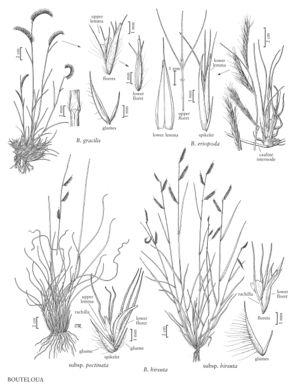Bouteloua eriopoda
Plants perennial; often shortly rhizomatous, stoloniferous, stolons long, densely woolly-pubescent. Culms 20-60(75) cm, wiry, decumbent, rooting at the lower nodes; lower internodes densely woolly-pubescent. Sheaths mostly glabrous or sparsely pilose, usually pilose near the ligules; ligules 0.1-0.4 mm, of hairs; blades 2.5-6 cm long, 0.5-2 mm wide, scabrous adaxially, margins with papillose-based hairs basally. Panicles (1)2-16 cm, with (1)2-8 branches; branches 14-50 mm, persistent, densely woolly-pubescent basally, with 8-18 spikelets, axes terminating in entire, sometimes scarious apices; disarticulation above the glumes. Spikelets pectinate, with 1 bisexual floret and 1 rudimentary floret. Glumes unequal, smooth or scabrous; lower glumes 2-4.5 mm; upper glumes 4.5-8(9) mm, glabrous, scabrous, or with hairs, hairs to 0.5 mm, not papillose-based; lower lemmas 4-7 mm, pubescent basally, glabrous or sparsely puberulent distally, acuminate, central awns 0.5-4 mm, lateral awns absent or shorter than 1 mm; lower paleas acuminate, unawned; anthers 1.5-3 mm, yellow to orange; rachilla segment to second florets about 2 mm, with a distal tuft of hairs; upper florets rudimentary, an awn column terminating in 3 awns of 4-9 mm. Caryopses 2.5-3 mm. 2n = 20, 21, 28.
Distribution
Kans., Okla., Colo., N.Mex., Tex., Utah, Calif., Wyo., Ariz., Nev.
Discussion
Bouteloua eriopoda grows on dry plains, foothills, and open forested slopes, often in shrubby habitats, and also in waste ground. It is usually found between 1000-1800 m, but extends to 2500 m. Once a dominant in much of its range, under heavy grazing B. eriopoda persists only where protected by shrubs or cacti because it is highly palatable. Its range extends from the southwestern United States to northern Mexico.
Selected References
None.
